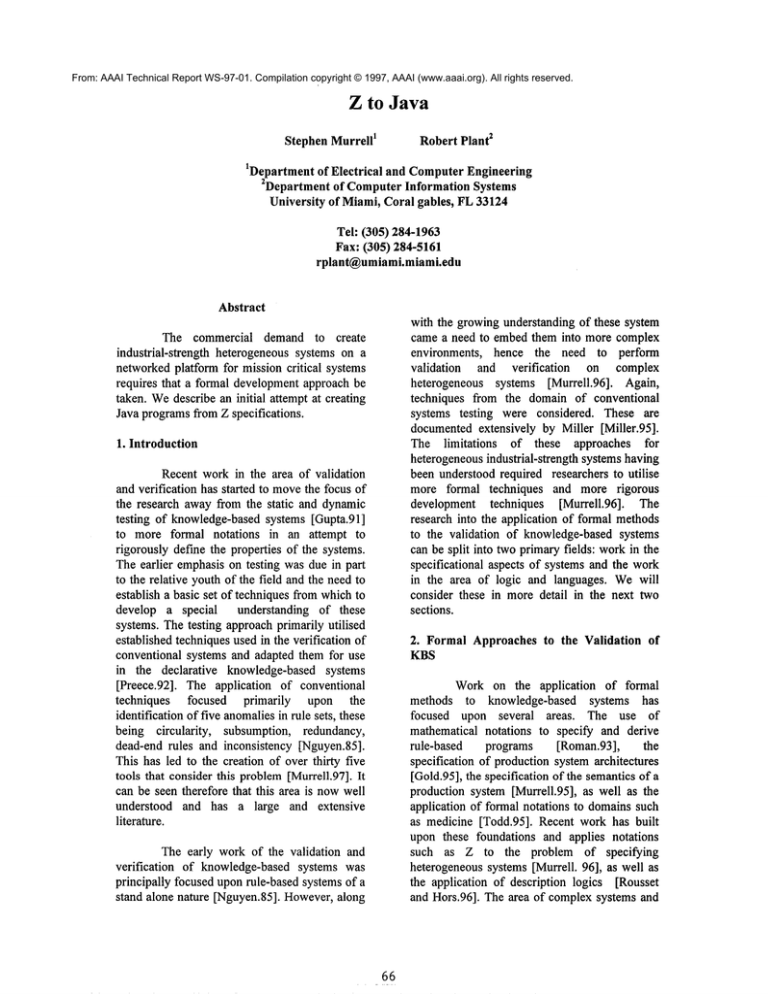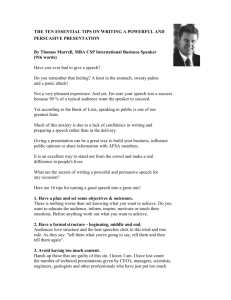
From: AAAI Technical Report WS-97-01. Compilation copyright © 1997, AAAI (www.aaai.org). All rights reserved.
Z to Java
IStephen Murrell
2Robert Plant
1Departmentof Electrical and ComputerEngineering
2Department of ComputerInformation Systems
University of Miami,Coral gables, FL33124
Tel: (305) 284-1963
Fax: (305) 284-5161
rplant@umiami.miami.edu
Abstract
with the growing understanding of these system
came a need to embed them into more complex
environments, hence the need to perform
validation
and verification
on complex
heterogeneous systems [Murrell.96]. Again,
techniques from the domain of conventional
systems testing were considered. These are
documentedextensively by Miller [Miller.95].
The limitations
of these approaches for
heterogeneousindustrial-strength systems having
been understood required researchers to utilise
more formal techniques and more rigorous
development techniques [Murrell.96].
The
research into the application of formal methods
to the validation of knowledge-based systems
can be split into two primary fields: workin the
specificational aspects of systems and the work
in the area of logic and languages. Wewill
consider these in more detail in the next two
sections.
The commercial demand to create
industrial-strength heterogeneous systems on a
networkedplatform for mission critical systems
requires that a formal development approach be
taken. Wedescribe an initial attempt at creating
Java programsfrom Z specifications.
1. Introduction
Recent work in the area of validation
and verification has started to movethe focus of
the research away from the static and dynamic
testing of knowledge-based systems [Gupta.91]
to more formal notations in an attempt to
rigorously define the properties of the systems.
The earlier emphasis on testing was due in part
to the relative youth of the field and the need to
establish a basic set of techniques from whichto
develop a special understanding of these
systems. The testing approach primarily utilised
established techniques used in the verification of
conventional systems and adapted them for use
in the declarative knowledge-based systems
[Preece.92]. The application of conventional
techniques
focused primarily
upon the
identification of five anomaliesin rule sets, these
being circularity,
subsumption, redundancy,
dead-end rules and inconsistency [Nguyen.85].
This has led to the creation of over thirty five
tools that consider this problem[Murrell.97]. It
can be seen therefore that this area is nowwell
understood and has a large and extensive
literature.
2. Formal Approaches to the Validation of
KBS
Work on the application of formal
methods to knowledge-based systems has
focused upon several areas. The use of
mathematical notations to specify and derive
rule-based
programs [Roman.93],
the
specification of production system architectures
[Gold.95], the specification of the semantics of a
production system [Murrell.95], as well as the
application of formal notations to domainssuch
as medicine [Todd.95]. Recent work has built
upon these foundations and applies notations
such as Z to the problem of specifying
heterogeneous systems [Murrell. 96], as well as
the application of description logics [Rousset
and Hors.96]. The area of complex systems and
The early work of the validation and
verification of knowledge-based systems was
principally focused upon rule-based systems of a
stand alone nature [Nguyen.85]. However,along
66
the inherent complexity of formal notations has
also caused a growth in research in the area of
tools to support such developments, including
the B-Method (B-Tool & B-Toolkit), Estelle
(EDT: Estelle Development Toolkit), EVES
(Z/EVES) 1,
PROSPECTRA (PROgram
development
by
SPECification
and
TRAnsformation) [Hoffan.91],
VDMDomain
Compiler [Schmidt.91], ProofPower, Mural,
IPTES Toolset, DST-Fuzz [Woodcock.93]. In
order to derive maximaleffect from the research
there has been a move to standardise 2 the
notations
and both Z and VDM-SL are
undergoing ISO Standardisation.
3. Languages for KBS
The history of AI and knowledge-based
systems is intertwined with the history of
programminglanguages, as LISP3 is at the core
of both these two fields of computerscience. The
adoption of LISP as the default AI language
from the early days through to the modem
variances of LISP such as CLIPS4 (C Language
Integrated Production System) and OPS5has
also been interspliced
with theoretical
developments in programming language theory
through the logic-based languages such as
Prolog [Clocksin.81] and Godel, and the advent
of expert systems shells such as VP-Expert,
Expert, 5 6.
ART, AIM, CRYSTAL, CxPERT
However, the adoption of knowledge-based
systems has been hamperedby the unwillingness
of industry and commerce to adopt these
"esoteric" languagesthat fall outside of their inhouse standards and programming expertise.
The most successful of the expert systems
implementation languages are C and C++,
which are both understandable to the commercial
in-house programming staffers
and easily
interoperates with other systems.
I
http://www.comlab.ox.ac.uk/archive/formal-
methods.html#VDM
2http://www.comlab.ox.ac.uk/oucl/groups/zstand
ards/
3 http://www8.informatik.unierlangen.de/html/lisp/histlit.html
4http://rodau.ed.umuc.edu/-rshecter/inss555/clip
s/cliphtml/voll .html
5 http://knight3.cit.ics.saitama-
4. KBSThrough Java
The use of C and C++ as preferred
development languages for knowledge-based
systems and the consequent use of these systems
in a heterogeneous environment has led to their
use in an increasing number of critical and
operationally dependent systems. Hencethe need
to utilise formal techniques for specification and
then map these specifications
to a C/C++
environment.There are currently three tools that
7 Toolbox
perform this activity:
The LOTOS
which supports specification in LOTOS
and then
via a tool set the development of C code
prototypes;
RAISEs which assists in the
development of VDM-SLspecifications
into
C++ , and PET DINGO[Woodcock.93] which
support the translation of specifications written
in the Estelle language into C++code. LOTOS
Toolbox and RAISE are both commercial
products while PET DINGOis in the public
domain.
The advent of the intemet and its
impact upon industry and commerceas a vehicle
for electronic data interchange and electronic
trading has led to the increasing need to have
access to information and knowledgeboth intraand inter-organisationally. This is fueling the
adoption of Java [Deitel.97]
as a nascent
standard mediumfor the exchangeof executable
objects.
For these reasons we chose Java as the
target language for the creation of executable
extensions of Z specifications.
5. The System
The originally intention for Z was not to
produce executable specifications,
but most
industrial
users of Z do tend to adopt a
specification style which makes schemas appear
almost to be programs,with pre-conditions first,
the "assignments"to output variables, and ffmally
somepost-condition testing. Our systemrelies to
a certain extent on the procedural nature of
specifications, but is capable of reordering
components when necessary.
This makes
7
u.ac.j p/ai/expert.html
6 http://www.ioe.ac.uk/hgm/expert3.html
http://wwwtlos.cs.utwente.nl/lotos/
s http://www.ifad.dk/
67
translation
into a practical
language an achievable goal.
programming
For user convenience, we chose to
accept specifications in the Latex Z style. These
specifications are mechanically translated into
Java applets.
6. AnIllustration
For reasons of space, we take as an
examplethe exceptionally simple specification
of a counter limited to the range [0,max] with
three access operations: Initialise sets the
counter to zero; Increase adds someincrement to
the counter; Read returns both the value of the
counter and the space remaining for further
increments.
For this style of specification, a single class
definition is created; it has two integer members
(n and max), three
public
methods,
corresponding to the three schemasthat include
Acounter or .=counter, and one private method
whichtests the validity of the state of a counter
according to its predicates. Each of these four
methods returns a boolean result, indicating
success or failure. In addition to the three
"active" methods for Initialise,
Increase and
Read, three "passive" methodsare also created,
for testing whether the operation is in-domainor
not.
public class counter
{ public int n;
public int max;
-- Counter
n: N
max: N
public boolean valid ()
{ if (! (n>=O)) return(false)
if (t (n<=max)) return(false)
return(true);
n>O
n < max
public boolean can_initialise()
{ return(true);
public boolean initialise()
{ if (tcan_initialise())
return(false)
n=O;
max=lO;
return (valid())
-- Initialise
ACounter
n’ =0
max’ = 10
Initialise
is always in domain (it has no
preconditions), so can_initialise() alwaysreturns
true. Initialise simply sets the class membersas
directed, andtest, the validity of the result.
Increase-A Counter
inc?: N
public boolean
can increase(int inc)
{ if (1 (n+inc<=max))
return(false)
return(true);
n + inc? _< max
n’ = n + inc?
max’ = max
Read
.~. Counter
val!: N
space!: N
public boolean increase(int inc)
{ if ( !can_increase(inc))
return(false)
n=n+inc;
return (valid())
val! = n
space! = max- n
Inc? is syntactically
marked as an input
parameter. The translation algorithm sorts the
predicates of a schemainto dependencylayers:
predicates that contain only input variables and
68
constants become part of the in-domain test.
Predicates containing input variables, constants,
and "assignments"
to new variables
are
translated first, makingmore variables available
to allow translation of other predicates. This
simple method is successful for most real
industrial Z specifications, but can not handle
"subtle" assignments (e.g. n:N; n>3 ; n<5,
or g=n+2), a problemthat is still the subject of
muchon-going research. Usually, predicates that
appear to be multiple assignments (e.g.
n’=n+:l.;
n’=x) may be resolved as one
assignmentand one test.
to indicate the validity of the schema’sprivate
members(See Figure 1).
Counter
n= [-~--]
O valid
[Initialise [
[Increase [
[Read [
max=~
O not valid
inc?=
val=~ --’’]
----’-’]
space=[
Figure 1. Counter
public boolean can read()
{ return(true) ;
Additionally, the translator mayproduce another
"applet" class that drawsthe originally provided
Z specification for reference during testing.
public boolean
read (counter_read_outputR)
{ if (!can_read()
return(false)
R.val=n;
R. space=max-n;
return(valid())
7. Conclusions
The paper has shownin outline the process of
deriving an executable program from a Z
specification. The exampleuse to illustrate the
process was extremely simple, but the same
principles apply to larger scale problems. One
particular benefit is the ability to experiment
with a specification remotely, in line with the
9 project, in particular
aims of the ARPACAETI
this work is related to that of Gamble and
Murrell underthis project [Murrell. 96a].
Val! and Space! are recognised as output
parameters; as Java insists upon passing simple
values (such as integers) by value, and class
objects by reference, a special dummy
class with
member representing
each of the output
variables must be created to force call by
reference, allowing output.
The code produced by this mechanical
translation is not particularly efficient (there is
much duplication of code, especially in the
domainchecking), but that is not the point. We
do not intend to create or replace the application
itself, but to producea remotely testable object
directly and independentlyfrom its specification.
public class counter_read_output
{ int val;
int space; }
The translator also produces an "Applet" class
for testing the executiablespecification:
public class test counter
extends Applet
8. References
{ ......
}
Clocksin, W.F., &Mellish, C.S., 1981
Programmingin Prolog
Springer Verlag
Test counter draws a windowwith "textfields"
for each of the members,and buttons for each of
the methods; the buttons are surrounded by
editable textfields for each of their input
variables, and non-editable textfirelds for each of
their output variables; the buttons are not visible
when the operations they represent are not in
domain. Additionally, "radio buttons" are added
Deitel, H.M., &Deitel, P.J., 1997
Howto Program Java
Prentice Hall
9 http://www,fwl.org/techpolicy/caeti.html
69
Preece, A.D., Shinghal, R., Batarekh, A. 1992
"Verifying expert systems: A logical framework
and a practical tool"
Expert Systems with Applications 5:421-436
Gold, D.I., &Plant, R.T
"Towardsthe Formal Specification of an Expert
System"
International Journal of Intelligent Systems.Vol.
9, Number9 August 1994, pp739-768
Roman,G., Gamble,R.F., Ball, W. 1993
Formal Derivation of Rule-Based Programs
IEEETrans. on Software Engineering, Vol. 19.,
No.3., March 1993 pp277-296
Gupta, U. 1991
Validating and Verifying Knowledge-Based
Systems
IEEE ComputerSociety Press
Rousset, M.C., & Hors, P. 1996
"Modeling and Verifying Complex Objects: A
Declarative Approach based upon description
logics"
AAAI Workshop Notes: Verification
and
Validation of Knowledge-based Systems and
Subsystems, Schmolze, J., & Vermesan, A.
Portland, Oregon. August 5th 1996
Hoffmann, B., & Krieg-Bruckner, B. 1991
"The PROSPECTRASystem" In, VDM’91
Formal Software DevelopmentMethods, 4th Int.
Symposium of VDMEurope, Vol. 1. Editors:
Prehn, S., & Toetenel, W.J., Lecture Notes in
ComputerScience 551., Springer Verlag. pp668671
Miller, L. 1995
Guidelines for the Verification and Validation of
Expert Systems and Conventional Software
EPRI TR-103331, Project 3093-01
SAIC, McLeanVirginia.
Schmidt, U., & Horcher, H., 1991
"The VDMDomain Compiler AVDMClass
Library Generator" In, VDM’91 Formal
Software Development Methods, 4th Int.
Symposiumof VDMEurope, Vol. 1. Editors:
Prehn, S., &Toetenel, W.J., Lecture Notes in
ComputerScience 551., Springer Verlag. pp675676
Murrell, S., &Plant, R.T. 1995
FormalSemantics for Rule-Based Systems
Journal of Systems&Software, Vol. 29, No3.
Murrell, S., Plant, R.T., Gamble,R. 1996
"Formal Specification of Rule-Based Systems
ThroughStyles"
AAAI Workshop Notes: 9th Workshop on
Validation & Verification of Knowledge-Based
Systems
Portland., Oregon, August1996
Murrell, S., &Gamble,R., and Butler, P. 1996a
"ZtoRefine 1.0 Users Guide"
Tech Report UTULSA-MCS-96-14Department
of Mathematical and Computer Sciences,
Univerity of Tulsa. Sept 1996
Murrell, S., Plant, R.T. 1997
"A Survey of Tools for the Validation
Verification of Knowledge-Based
Systems"
Decision Support Systems (To Appear 1997)
Nguyen, T.A., Perkins, W.A., Laffey,
Pecora, D. 1985
"Knowledgebase verification"
IJCAI pp 375-378
&
T.J.,
7O
Todd, B. 1995
Anintroduction to Expert Systems.
Technical Monograph PRG-95
Oxford University Computing
Oxford, England.
Laboratory,
Woodcock,J.C.P., &Larsen, P.G., (Eds) 1993
FME’93: Industrial Strength Methods, First
International
Symposiumon Formal Methods
Europe Odense, Denmark, April 1993. Lecture
Notes in ComputerScience 670. Springer Verlag.





